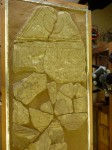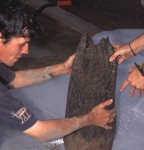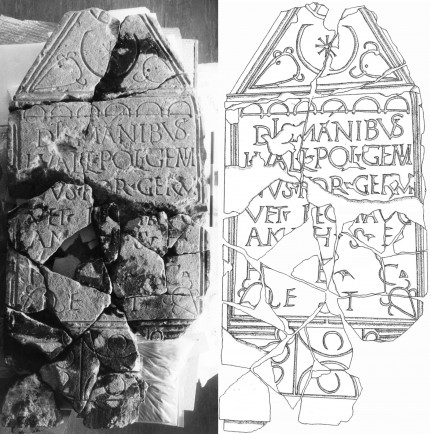 The tombstone of Lucius Valerius Geminus, veteran of the Legio II Augusta, one of the elite legions that first invaded Britain in 43 A.D. under the Emperor Claudius, the legion which defeated Boudica and built Hadrian’s wall, is going on public display at the Oxfordshire Museum in Woodstock for the first time since its discovery in 2003.
The tombstone of Lucius Valerius Geminus, veteran of the Legio II Augusta, one of the elite legions that first invaded Britain in 43 A.D. under the Emperor Claudius, the legion which defeated Boudica and built Hadrian’s wall, is going on public display at the Oxfordshire Museum in Woodstock for the first time since its discovery in 2003.
The tombstone was found in the foundations of the town wall near the west gate of Alchester, a Roman town two miles south of the modern Oxfordshire town of Bicester. The stone had been broken into 20 pieces and reused for rubble in the foundations of the stone wall which we know from coin evidence was built after 260 A.D. and before the abandonment of the town in the 5th century. The town was preceded by a Roman military base the construction of which, thanks to dendrochronological analysis of two wooden gateposts found at the front gate preserved by waterlogged ground, we can date incredibly precisely to between October of 44 A.D. and March of 45 A.D.
What makes this tombstone such a significant find is the biographical detail in the inscription describing a soldier who most likely participated in the initial conquest of Britain and then settled in the province after his retirement. It’s the only personal biography we have of anyone living in Oxfordshire before the Middle Ages, and the first for an individual veteran in the entire province of Britannia.
Here is the text of the inscription:
Dis. Manibus/ L(ucius) Val(erius) L(uci filius) Pol(lia tribu) Gemi/nus For(o) Germ(anorum)/ vet(eranus) Leg(ionis) [I]I Aug(ustae)/ an(norum) L. h(ic) s(itus) e(st)/ he(res) c(uravit)/ e(x) t(estamento)
“To the souls of the departed: Lucius Valerius Geminus, the son of Lucius, of the Pollia voting tribe, from Forum Germanorum, veteran of the Second Augustan Legion, aged 50(?), lies here. His heir had this set up in accordance with his will.”
 Forum Germanorum was a one-horse town in north-west Italy at the base of the Alps in what is today the Piemonte region. It was once part of the province of Gallia Cisalpina (Gaul on this side of the Alps) but had been granted Latin Rights in 89 B.C. under a law promoted by (and maybe even written by) Gnaeus Pompeius Strabo, father of the triumvir Gnaeus Pompeius Magnus. Lucius Valerius’s epitaph was inscribed 70 or so years later and his membership in the Pollia voting tribe still ranked a mention.
Forum Germanorum was a one-horse town in north-west Italy at the base of the Alps in what is today the Piemonte region. It was once part of the province of Gallia Cisalpina (Gaul on this side of the Alps) but had been granted Latin Rights in 89 B.C. under a law promoted by (and maybe even written by) Gnaeus Pompeius Strabo, father of the triumvir Gnaeus Pompeius Magnus. Lucius Valerius’s epitaph was inscribed 70 or so years later and his membership in the Pollia voting tribe still ranked a mention.
Since we know that he had to have died before the garrison left Alchester around 60 A.D., his approximate age at death (50), the general age of army recruits (17-25) and the standard term of service for a legionary (25-30 years), we can deduce he joined the legions during the reign of Tiberius (14-37 A.D.). The base of the Second Augustan Legion at that time was Strasbourg from which he may have participated in Caligula’s quasi campaign (he just executed a bunch of his own people and moved around, really) in Germany from 39-40 A.D. Less than two years later, the future emperor Vespasian became commander of Legio II Augusta and it was he who brought it from Strasbourg to Britain in 43 A.D.
It’s unlikely that Lucius Valerius died away from home and was buried on the spot. As noted in the inscription, the gravestone was inscribed and installed according to the explicit instructions in his will. Obviously he felt no need to be interred back home in Forum Germanorum — he’d probably been gone decades by then — because it wasn’t at all unheard of for soldiers on expedition to be returned home for burial even over great distances but he chose to rest eternally in British soil.
No accompanying burial was found during the 2003 excavation of the Alchester walls. This makes sense because he would have been buried outside of the city, probably along a road. What seems most likely to have happened is a couple of hundred years after his death and burial, Lucius’ gravestone was broken up and moved by cart to the construction site of the new town walls. It was probably a deliberate breakage and transport rather than someone collecting random broken stones because so much of it was found in the rubble foundation.
After its discovery, the tombstone was studied and painstakingly piece back together by experts at the Oxfordshire Museum. Starting July 20th, the gravestone of Lucius Valerius Geminus, first known legionary of Britannia, will be on display in the museum’s History in the Making Exhibition.
